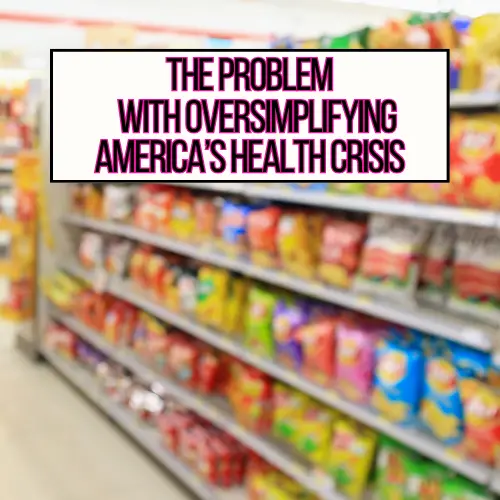According to the CDC, the prevalence of chronic, preventable diseases has steadily risen over the past two decades. And I, like many others, would love for that to change. However, it’s crucial to recognize that the issue is much more complex than it seems. It’s easy to blame it on “food additives” or “seed oils” but oversimplifying this issue risks ignoring the deeper challenges that keep us trapped in cycles of poor health.

Without getting too political, I want to discuss just some of the contributing factors to these rising rates of chronic disease. I think it’s incredibly important to understand that it’s so much more than additives and ingredients in our food! Are there areas we could be doing better? Of course! Is there corruption in the food industry by large corporations? Should we be a little skeptical? Yep, and I really do hope there are good intentions to improve them. However, it really is so much more nuanced than that.
I find it sad that there are so many people on social media, not to mention wellness influencers, that are really demonizing the health “experts” and well-educated medical professionals. Most of us are not working with large corporations, get paid very little, and are just trying to help others understand the complexities.
One theme I have been seeing a lot of are people expressing fear over what foods to buy or feeling food shame when consuming certain foods that wellness influencers tell you NOT to eat. This, in and of itself, can create disordered eating.
I am a big believer of evidence-based research – and why shouldn’t I be? Why would I want to add that extra stress to my life and question it all? I think we all want positive changes and for America to be healthier. However, I just ask that you keep an open mind because it is absolutely not black and white.
Factors that Affect the Rising Chronic Disease Rates
The rising rates of chronic disease are likely due to a complex mix of factors related to individual food choicse and beyond. For example, those who do not have access to grocery stores are at a higher risk of health conditions like heart disease, diabetes and obesity. One study found that people with less than a high school education had nearly twice the odds of having diabetes compared with those with a college degree.
Therefore, lack of access of nutrition education as well as social and economic environments have a significant impact on food choices. Below is a list of just some of the other factors that contribute to rising disease rates.
- Food deserts and accessibility make healthy food less accessible in many areas, leading people to rely on cheap, processed options. The social determinants of health affect quality of life and include economic stability, education access and quality, health care access, neighborhood and built environment, social community and context.
- Food labeling confusion – the misleading nutrition labels and health claims on packaging can confuse consumers leading to poor food choices.
- High-calorie, low-nutrient foods are now readily available and heavily marketed.
- Sedentary lifestyles.
- High levels of stress.
- Targeted Marketing. The food industry spends billions on marketing, often promoting unhealthy foods as “convenient” or “kid-friendly.” Children and teens are especially vulnerable to this advertising, and it can shape lifelong habits.
Labeling Differences in the United States
The number of times I have seen comments on social media stating America is unhealthy all because we have “food additive and chemicals that are banned in other countries”. Many of the comments refer to Red Dye 40 which is actually not banned in Europe – just labeled under a different name. I think it’s really important to understand some of these differences and why people have this perception.
The United States and European Union have different regulatory frameworks but with similar principles based on well-established risk-assessment procedures and risk-management measures. The United States uses a risk-based approach meaning that ingredients are deemed safe within specific limits or consumption.
The FDA approves a food if there is convincing evidence that no harm will result from the intended use of the additive. If research shows a certain ingredient can cause potential harm only at extremely high doses, the FDA may still approve it as it is unlikely to pose a risk. The United States looks at many factors when determining if an ingredient should be added, like economic factors.
On the other hand, the European Union often uses a more precautionary approach: meaning if there is any evidence of harm – even at lower doses- regulations may be more conservative. There are some ingredients that are banned in Europe but found in food in the United States. Also, there are additives banned in the U.S. but still found in European foods. Does this mean these additives are harmful? No, each country interprets the data differently.
Food Dyes
Food dyes are considered the most regulated additives in food all over the world. However, this still leads to differences among various countries. They are added to foods to compensate for color loss during processing or to make products more appealing to consumers.
In the United States, there are 9 artificial or synthetic food dyes approves for use. Four color additives that are approved in the U.S. are banned in Europe and 16 food dyes are authorized in the European Union that are not allowed in the U.S!
The Environmental Protection Agency (EPA) and the World Health Organization agree that Red Dye 40 is of low concern. Red Dye 40 is not banned in Europe but the label must come with a warning that it can cause hyperactivity in children. This is because there are studies that have found some children may be sensitive to food dyes.
To explain even further: Red Dye 40 has an acceptable daily intake (ADI) of 3.2 mg per pound. This translates to 476 mg for a 150-pound (68-kg) person. One study found that the average child aged 2 and up consumes .002 mg of red dye 40 per pound of body weight. Therefore, many countries still approves its’ use based on a risk-benefits approach. To put it simply, the available research shows that it is not harmful to the majority of consumers.
It is also known as:
- Red 40 Lake
- Red 40
- FD&C Red No. 40
- FD&C Red No. 40 Aluminum Lake
- Allura Red AC
- CI Food Red 17
- INS No. 129
- E129
BHA/BRT
These preservatives are restricted in Europe due to concerns about potential cancer risks, but are commonly used in American food products. The reason? The FDA’s review process considers potential health risks over a lifetime of dietary exposure.
Seed Oils
Why are seed oils getting such a bad rep all over social media? Some influencers claim that these oils are “pro-inflammatory” but most of the research has found the opposite effect. palm oil, soybean oil, and rapeseed oil are the three main types of vegetable oil that have dominated the world market due to their high yield, high oil production rate, and good stability.
A recent 2023 review funded by China, not the United States, evaluated 39 different seed oils. They found that strategies to shift the intake towards vegetable oils instead of fats, including butter, shortening and lard, would benefit human health. Even further, it was stated the intake of vegetable oils from various sources has distinctive effects on human health including antioxidant activity, anti-cancer, anti-inflammatory, prevention of CVD, anti-obesity, diabetes treatment, kidney and liver protection, and other health effects.
This is just ONE review – there are many more that even discuss that seed oils can have an anti-inflammatory effect. If you’re still nervous about seed oil consumption, olive oil and avocado oil have an abundance of research showing their positive effects. Read The Best Anti-Inflammatory Foods with Grocery List for more information!
What I am trying to say here is that the topic of food additives is complex and the US approach is based on scientific research and the dose in which we consume these ingredients. Could there be improvement? Probably – but the FDA is likely not out to get you by adding these additives. I think all experts agree that the recommendation of limiting calorically dense, ultra-processed foods is more of a priority.
The Dietary Guidelines

The Dietary Guidelines for Americans was created and developed to promote health and prevent disease based on, of course, evidence-based research from studies all over the world. Nearly the entire U.S. population consumes a diet that is not on par with these recommendations. Now, you could easily argue that this could be a major factor in the increase of chronic diseases in America.
Here’s a breakdown of some of the guidelines and how we are not meeting them:
- More than 90% of women and 97% of men do not meet the recommended intakes for dietary fiber. The Adequate Intake (AI) for fiber is 14 g/1000 kcal of intake per day.
- Only 12% of Americans consume 1.5–2 cup-equivalents of fruits and 2–3 cup-equivalents of vegetables daily.
- An estimated 75% of Americans are not meeting the recommended physical activity guidelines.
Other recommendations are consuming less than 10% of your calories from added sugars and saturated fats as well as limiting alcoholic beverages to two or less per day. You can read the entire 164-page Dietary Guidelines for Americans PDF for more information.
There is much more research cementing the principles of the dietary guidelines and their impact on our health than on the food additives that are banned in other countries and not the United States. I only say this to encourage others to try to meet these guidelines instead of being afraid to eat certain foods. Think about what you can ADD to your meals to meet these recommendations instead of so much focus on what to restrict.
More Resources on the Importance of Fiber:
— The Benefits of a High Protein, High Fiber Diet with Meal Plan
— 5-Day Low Carb, High Fiber Meal Plan
— 20 Recipes High in Protein and Fiber
— A Guide to High Protein and Fiber Dense Bean Salads
— All the Best Ways to Use Beans
This is Just Scratching the Surface
This is just a small portion of just how complex this issue really is. I didn’t go over half the “food additives” that are being demonized but I hope this helps others keep an open mind about all the misinformation that is on social media these days.
There are a lot of factors that are creating this health epidemic from lack of personal education, community support, socioeconomic factors, policies, corrupt organization and so on. Some could argue that individuals should be able to make their own food choices based on indulgence and personal preferences.
I am all for taking a closer look at the various corporations and corruption that may be occurring. With an open mind, I will keep hoping for positive change with the right solutions. Hopefully, solutions that are based on science and evidence that us health professionals believe in.
